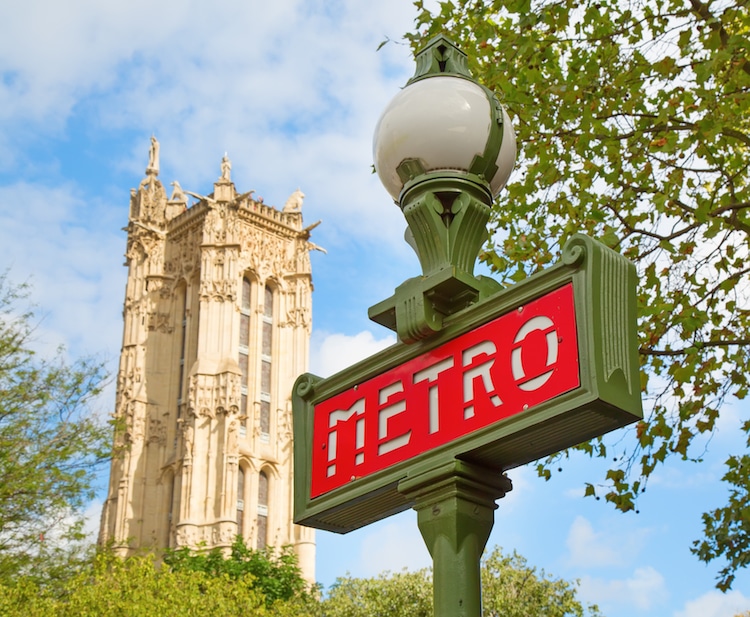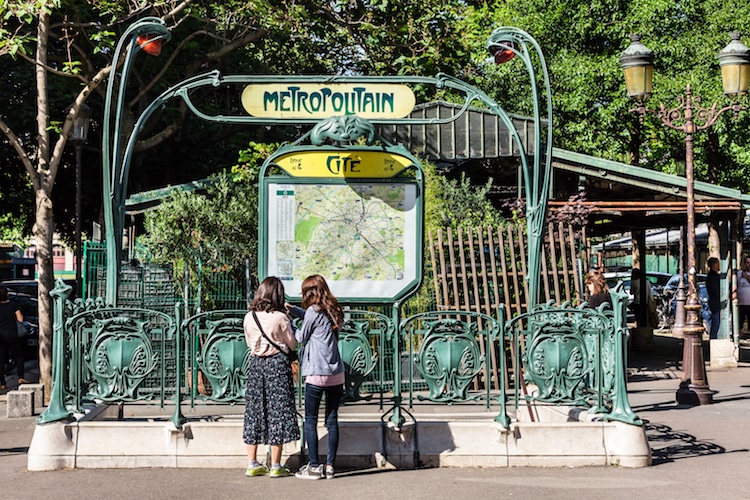
Stock Photos from Dennis van de Water/Shutterstock
Paris has no shortage of awe-inspiring architecture. With show-stealing sites like the Eiffel Tower and the Louvre Museum, the “City of Light” is famous for its larger-than-life landmarks. In addition to towering tourist destinations, however, Paris also showcases its architectural prowess on a much smaller scale, as demonstrated by its distinctive collection of Art Nouveau metro entrances.
Designed by French architect Hector Guimard at the turn of the 20th century, these avant-garde entryways have symbolized the city's Golden Age of art and architecture for over a century. Today, they continue to captivate, keeping the spirit of the Art Nouveau movement alive as they transport passersby to Paris' Belle Époque.
Hector Guimard and the Art Nouveau Movement

Hector Guimard and his wife Adeline (Photo: Wikimedia Commons Public Domain)
Hector Guimard was born in Lyon, France, in 1867. At the age of 15, he enrolled in Paris' École nationale supérieure des arts décoratifs, a school dedicated to the decorative arts. Here, he studied the work of Eugène Emmanuel Viollet-le-Duc, the architect responsible for several significant restoration projects across France (including a complete refurbishment of Notre-Dame Cathedral in the middle of the 19th century).
While Viollet-le-Duc served as a model for Guimard, he found inspiration not in his Neo-Gothic style and interests, but in his logical approach to architecture. “I have merely applied the theory of Viollet-le-Duc, but without allowing myself to be seduced by medieval forms,” Guimard wrote in a letter to L.C. Boileau. This reinterpretation of Viollet-le-Duc's ideas would later lay the foundation of the Art Nouveau movement.
Guimard pioneered the Art Nouveau aesthetic in the 1890s with two important Paris-based commissions: the lettering and street numbers of the Hotel Villa de la Réunion and the entire design of Castel Béranger. In both cases, Guimard incorporated several elements intrinsic to Art Nouveau, including an aesthetic interest in nature, the use of curved lines and sinuous silhouettes, and a preference for balanced yet asymmetrical forms.
Following the success of these projects, Guimard was appointed to undertake his most ambitious job yet: designing the entrances to the city's underground stations.
Paris Métropolitain Entrances
In the years leading up to the Exposition Universelle, a World's Fair held in 1900, Paris was busy building the Métropolitain, or Métro, a new public transit network. In order to make the above-ground components of this new underground system as aesthetically pleasing as possible, the Compagnie du chemin de fer métropolitain de Paris, or Paris Metropolitan Railway Company, commissioned Guimard to design entryways that were “as elegant as possible.”
In order to meet this criteria, Guimard opted to craft his entrances out of cast iron set in concrete and painted a shade of green evocative of oxidized brass. The use of cast iron allowed him to construct the curved forms characteristic of his style, and concrete enabled him to incorporate sculpted details throughout each design—whether rendered as a roofed édicule structure or an open entourage model.
Édicule

Stock Photos from Arcady/Shutterstock
Guimard's édicule (“kiosk”) metro entrance features a fan-like awning made of glass. Undoubtedly inspired by the delicate wings of a dragonfly (one of Art Nouveau's major motifs), this style epitomizes the movement's interest in reinterpreting organic forms as functional objects. Today, only two original édicule entryways exist in Paris.
Entourage

Stock Photos from EQRoy/Shutterstock
The other type of Guimard-designed entryway is known as entourage (“enclosure”). This genre features two serpentine, stem-like lamp posts joined by an equally sinuous arch. Each stalk is topped with a glowing red orb reminiscent of either an insect's eye or a flower bud.
Both the édicule and entourage entryways are adorned with either “Métropolitain” or “Métro,” rendered in a typeface that has come to represent Art Nouveau.
Similar Sign Styles
Between 1900 and 1912, 141 of Guimard's entrances were installed all over Paris. Today, 86 remain—though they're often confused with other aesthetically similar types of signage.
Val d'Osne

Stock Photos from Allen.G/Shutterstock
In the 1920s, the Nord-Sud Company (the operator of the metro's underground trains) decided to add more signposts to stops around Paris. The earliest of these designs is the Val d'Osne, a style that frames the word “METRO” in an elaborate cast-iron frieze topped with an orb-like lamp.
Dervaux

Stock Photos from Fedor Selivanov/Shutterstock
The Val d'Osne variant was succeeded by the Dervaux model. Introduced in the 1930s, these posts were crafted at the height of the Art Deco movement. This timing is evident in the Dervaux‘s design, which features the word “METRO” set in a frame featuring a streamlined silhouette and linear accents.
Post-War Designs

Stock Photos from Tupungato/Shutterstock
After World War II, the metro signs shed their lamps and became more minimalistic. While many—including signs comprising a simple yellow “M” in a circle—abandoned Guimard's signature color scheme and cast-iron composition, some retained this aesthetic as a final homage to the artist.
Guimard's Legacy

Stock Photos from Premier Photos/Shutterstock
In the years following their installation, Guimard's metro entryways were met with mixed reviews. While many people—including master of Surrealism Salvador Dalí, who claimed the “divine entrances . . . can descend into the region of the subconscious of the living and monarchical aesthetic of tomorrow”—enjoyed their elaborate designs, others thought they were over-the-top and even “un-French.”
During the second half of the 20th century, however, the structures were increasingly embraced. Today, the 86 remaining entryways are classified as historical monuments, ensuring they will remain a staple of Parisian streets for years to come.
Related Articles:
Magnificent Art Nouveau Architecture of the Great Antoni Gaudí
History of the Musée d’Orsay: From Parisian Train Station to World-Class Art Museum























































































